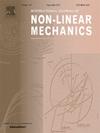Exact solutions and wave interactions for one-dimensional two-phase thin film model of a perfectly soluble antisurfactant
IF 3.2
3区 工程技术
Q2 MECHANICS
International Journal of Non-Linear Mechanics
Pub Date : 2025-09-22
DOI:10.1016/j.ijnonlinmec.2025.105262
引用次数: 0
Abstract
In this article, we obtain some exact solutions to a new hyperbolic system of quasilinear partial differential equations which describes the two-phase thin film model of a perfectly soluble antisurfactant by using symmetry analysis. Lie’s method provides a group of transformations for which the set of solutions remains invariant and through the help of push-forward actions, optimal classes are constructed. The aid of optimal classes facilitates exact solutions of the system. Additionally, we compute some traveling wave solutions of the governing system with the help of special transformations. For each phase, the evolution of the film thickness and concentration gradient is characterized by geometric representation of the solutions. The weak discontinuity behavior across a solution curve is analyzed as time progresses. In addition, the propagation of characteristic shock and the corresponding collision between the characteristic shock and the weak discontinuity are discussed. The reflected and transmitted wave amplitudes, along with the jump in shock acceleration influenced by the incident wave after interaction, are computed.
完全可溶抗表面活性剂一维两相薄膜模型的精确解和波相互作用
本文用对称分析的方法,得到了描述完全可溶抗表面活性剂两相薄膜模型的一类新的拟线性偏微分双曲方程组的精确解。李氏方法提供了一组变换,其解集保持不变,并通过前推动作的帮助,构造了最优类。最优类的帮助有助于系统的精确解。此外,我们还利用特殊变换计算了控制系统的一些行波解。对于每个相,膜厚度和浓度梯度的演变是由溶液的几何表示来表征的。随着时间的推移,分析了解曲线上的弱不连续行为。此外,还讨论了特征激波的传播以及相应的特征激波与弱不连续面的碰撞。计算了反射波和透射波振幅,以及入射波作用后冲击加速度的跃变。
本文章由计算机程序翻译,如有差异,请以英文原文为准。
求助全文
约1分钟内获得全文
求助全文
来源期刊
CiteScore
5.50
自引率
9.40%
发文量
192
审稿时长
67 days
期刊介绍:
The International Journal of Non-Linear Mechanics provides a specific medium for dissemination of high-quality research results in the various areas of theoretical, applied, and experimental mechanics of solids, fluids, structures, and systems where the phenomena are inherently non-linear.
The journal brings together original results in non-linear problems in elasticity, plasticity, dynamics, vibrations, wave-propagation, rheology, fluid-structure interaction systems, stability, biomechanics, micro- and nano-structures, materials, metamaterials, and in other diverse areas.
Papers may be analytical, computational or experimental in nature. Treatments of non-linear differential equations wherein solutions and properties of solutions are emphasized but physical aspects are not adequately relevant, will not be considered for possible publication. Both deterministic and stochastic approaches are fostered. Contributions pertaining to both established and emerging fields are encouraged.

 求助内容:
求助内容: 应助结果提醒方式:
应助结果提醒方式:


